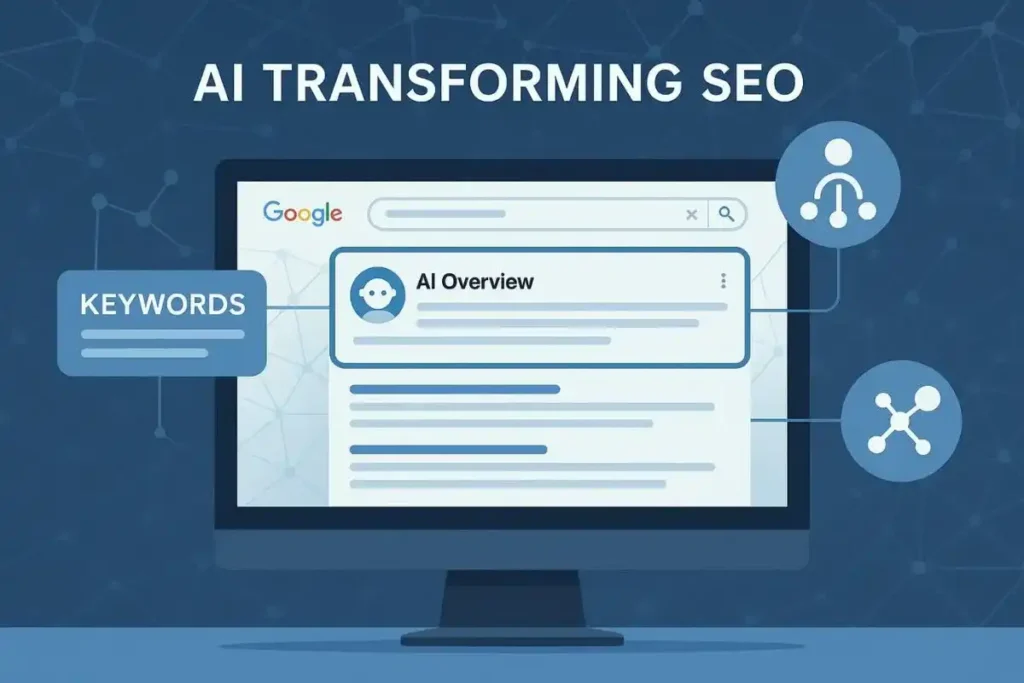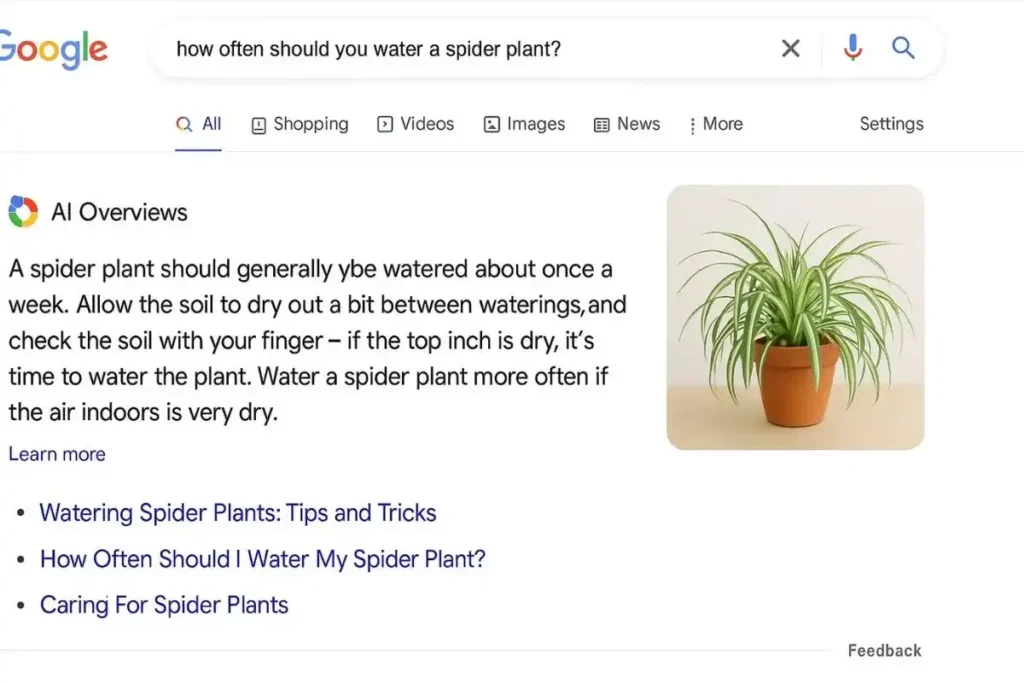
The SEO world is buzzing — and not in a good way. Since the rollout of AI Overviews by Google, many SEO professionals and website owners have started to panic. Some believe SEO is dead, while others are already pivoting to different career paths.
Related: Agentic Checkout: How Google Just Killed the Checkout Page
But is SEO really dead?
Not at all.
Let’s dive deep into what’s really happening and how you can adapt your SEO strategy for the AI era.
What Are Google AI Overviews?
Google’s AI Overviews are summaries that appear at the top of search results. They’re powered by artificial intelligence and designed to give users quick, well-organized answers — without clicking through to a website.
These summaries include:
- A human-like paragraph summarizing the topic
- Links to source websites
- Bullet-pointed highlights for better readability
For example, if you search for “SEO,” Google may now show you an intelligent overview of the topic — with citations — above all traditional search results.
How Do AI Overviews Actually Work?
Google’s summaries aren’t just stitched together by bots. They’re generated using cutting-edge AI technologies, including:
- 1. Gemini 1.5 Pro: A highly advanced AI model that reads, understands, and rewrites long content in a human-like tone.
- 2. RAG (Retrieval-Augmented Generation): This allows the AI to pull real-time data from verified sources and use it to create fresh, unique answers.
- 3. LLMs (Large Language Models): LLMs understand user intent and context, allowing Google to create natural, fluid answers — similar to those written by human experts.
This means Google is not just summarizing, it’s regenerating content into a mini-article from top-tier sources.
Why Are People Saying SEO Is Dead?
The concern is understandable:
- If users get everything they need from the summary, why click on your website?
- Could this lead to a drop in organic traffic?
- Are we giving away content for free?
These are valid questions. But let’s look at the full picture — it’s not as dark as it seems.
The Full Picture (Without Panic)
Click-through rates have not dropped significantly
Many people feared that Google’s AI Overviews would kill website traffic. However, the data tells a different story. In fact, in many cases, click-through rates (CTR) have remained stable. Surprisingly, some websites have even seen an increase in clicks.
Why does this happen? When users read a quick summary generated by AI, they often want more details. This brief overview sparks their curiosity. As a result, users are more likely to click on the source link provided under the AI response. This means that if your content is listed as a source, you may benefit from the AI Overview rather than lose traffic.
Moreover, AI Overviews often include structured summaries. These summaries usually list key points with clear citations. When users see your site linked in that list, they trust your credibility. Because of that, they may choose to visit your page directly to dig deeper or verify the information.
Additionally, many search queries still require in-depth answers. AI can summarize information, but it cannot fully replace detailed articles, expert opinions, or personal stories. Therefore, high-quality content still matters. When your article provides unique insights or value, users will want to read it in full.
In conclusion, the fear of losing all SEO traffic may be overstated. While AI Overviews do change how results are displayed, they do not automatically reduce clicks. In many situations, they can guide more users to your content—especially if your site appears as a trusted source.
Google AI Overviews do not appear for all search queries
They mostly show up for:
- Informational or educational questions
- Recipe content
- Simple, general queries
They do not show up for:
- Product or purchase-intent queries
- Local service searches
- Opinion-based or complex questions
If your site focuses on e-commerce, local services, medical or tech reviews, or transactional keywords, you’re still safe — and may even benefit.
How to Check if Your Site Appears in AI Overviews
Right now, Google Search Console (GSC) doesn’t provide dedicated data for AI Overviews. But you can:
- Manually search your target keywords
- Check if your site is cited in the AI summary
- Use Visual SERP tracking tools like Ziptiedev for real-time tracking
Expect Google to roll out AI Overview tracking reports in GSC soon — so keep an eye out.
The New “Not Provided”?
We’re seeing a new phase of the infamous “Not Provided” era. Your content gets pulled and displayed at the top, but traffic isn’t guaranteed unless you’re cited.
However:
If your content is the source, Google will credit your website as the original.
Related: How to Rank Higher on Google and Boost Your Website Visibility
This means:
- Clear, well-structured content increases your visibility
- Authoritative websites in niche industries are favored
- Smart formatting can position your site as a trusted source

Related: How to Improve Website Speed and Boost Performance in 2025
How to Adapt Your SEO Strategy for Google AI Overviews
1. Focus on Search Intent, not just Keywords
Focusing on search intent means understanding the real reason behind a user’s query. Are they trying to learn something, compare options, make a purchase, or solve a problem? When you know this, you can create content that speaks directly to their need. For example, someone searching “best running shoes” likely wants to compare products, not just read a definition. Therefore, instead of stuffing your page with keywords, think about what the visitor hopes to find. Then, guide them clearly through helpful, relevant information. This method improves your SEO while also enhancing user engagement and building trust.
2. Provide Direct Answers
To rank in AI Overviews, you must offer clear and concise answers to user queries. Start by identifying the main question behind each search intent. Then, respond with a straightforward sentence at the beginning of your paragraph. This helps AI models understand your content quickly. Additionally, organize your information using headers and bullet points. When content is structured well, it’s easier for AI to pull relevant details. As a result, this increases your likelihood of being featured. Therefore, focus on clarity and usefulness from the very first line.
3. Offer Real Value
Back your content with:
- Data and statistics
- First-hand experience
- Professional insights
Avoid shallow blog posts or outdated info.
4. Use Entities and Semantic Keywords
Linking your content to well-known entities and related terms in your niche helps search engines better understand what your page is about. When you use recognizable brands, people, places, or concepts in your writing, Google can connect your page to broader topic clusters. Consequently, your content becomes more relevant and authoritative. For example, if you’re writing about SEO, mentioning terms like “Google Search Console” or “keywords” signals strong topical relevance. Additionally, semantic keywords—those closely related in meaning to your main topic—make your content richer and more natural. This approach improves your chances of ranking for both primary and related search queries.
5. Implement Structured Data
Use:
- FAQ schema
- Article or Product markup
This improves your content’s chances of appearing in AI Overviews and featured snippets.
Conclusion: SEO Isn’t Dead — Bad SEO Is
Google is evolving, and only those who evolve with it will survive.
SEO professionals who:
- Understand their audience
- Offer genuine answers
- Structure content intelligently
…will thrive in this new era.
If you run a store or a service-based business, now is not the time to cut your SEO team — it’s time to empower them.
And if you’re still panicking after reading this?
Maybe it’s time to stop burying your head in the sand — and start adapting instead.
